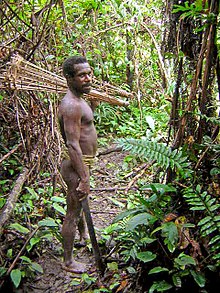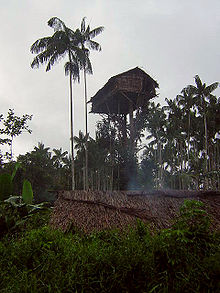Korowai people: Difference between revisions
→Contact with Westerners: wikilink, correct formatting |
PermanentE (talk | contribs) |
||
| Line 42: | Line 42: | ||
In May 2006, tour-guide Paul Raffaele led an Australian ''[[60 Minutes (Australian TV program)|60 Minutes]]'' crew to report on these people.<ref name="60min">{{cite news|url=http://sixtyminutes.ninemsn.com.au/sixtyminutes/stories/2006_05_21/story_1650.asp|title=Last cannibals|date=21 May 2006|author=Ben Fordham|publisher=NineMsn|accessdate=2006-10-25 |archiveurl = http://web.archive.org/web/20060821015435/http://sixtyminutes.ninemsn.com.au/sixtyminutes/stories/2006_05_21/story_1650.asp <!-- Bot retrieved archive --> |archivedate = 2006-08-21}}</ref> After a few days' filming, the crew were allegedly approached by a man who claimed his 6-year old nephew Wa-Wa had been accused of being a Kakua ([[witch doctor]]), and was in danger of being cannibalised. The ''60 Minutes'' crew declined to offer assistance. Paul Raffaele approached the rival [[Seven Network]], who agreed to send a ''[[Today Tonight]]'' crew to remove Wa-Wa from the area. Before being able to gain access to them, the crew were deported by Indonesian authorities at the Papuan capital of [[Jayapura]] over [[Visa (document)|visa]] issues.{{Fact|date=February 2007}} |
In May 2006, tour-guide Paul Raffaele led an Australian ''[[60 Minutes (Australian TV program)|60 Minutes]]'' crew to report on these people.<ref name="60min">{{cite news|url=http://sixtyminutes.ninemsn.com.au/sixtyminutes/stories/2006_05_21/story_1650.asp|title=Last cannibals|date=21 May 2006|author=Ben Fordham|publisher=NineMsn|accessdate=2006-10-25 |archiveurl = http://web.archive.org/web/20060821015435/http://sixtyminutes.ninemsn.com.au/sixtyminutes/stories/2006_05_21/story_1650.asp <!-- Bot retrieved archive --> |archivedate = 2006-08-21}}</ref> After a few days' filming, the crew were allegedly approached by a man who claimed his 6-year old nephew Wa-Wa had been accused of being a Kakua ([[witch doctor]]), and was in danger of being cannibalised. The ''60 Minutes'' crew declined to offer assistance. Paul Raffaele approached the rival [[Seven Network]], who agreed to send a ''[[Today Tonight]]'' crew to remove Wa-Wa from the area. Before being able to gain access to them, the crew were deported by Indonesian authorities at the Papuan capital of [[Jayapura]] over [[Visa (document)|visa]] issues.{{Fact|date=February 2007}} |
||
In January-February 2011, the BBC documentary ''[[Human Planet]]'' commissioned the Korowai building of a treehouse 35m high. In the episode it was explained that the Korowai built this treehouse this high to escape from the floods, biting insects, and enemy tribes. In reality the local korowai clan showed the BBC film crew three possible trees that a tree-house could be built in, and the BBC producer pick the tallest. |
In January-February 2011, the BBC documentary ''[[Human Planet]]'' commissioned the Korowai building of a treehouse 35m high. In the episode it was explained that the Korowai built this treehouse this high to escape from the floods, biting insects, and enemy tribes. In reality the local korowai clan showed the BBC film crew three possible trees that a tree-house could be built in, and the BBC producer pick the tallest.{{Fact}} |
||
==Cannibalism== |
==Cannibalism== |
||
Revision as of 08:07, 12 May 2011
- This article is about the ethnic group in New Guinea. For the Māori cloak, see Māori traditional textiles.

The Korowai, also called the Kolufo, are a people of southeastern Papua (i.e., the southeastern part of the western part of New Guinea). They number about 3,000.[1] Until 1970, they were unaware of the existence of any people besides themselves.[2]
Language
Their language belongs to the Awyu-Dumut family (southeastern Papua) and is part of the Trans–New Guinea phylum. A grammar and a dictionary have been produced by a Dutch missionary linguist.
Living

The majority of the Korowai clans live in tree houses on their isolated territory. Since 1980 some have moved into the recently opened villages of Yaniruma at the Becking River banks (Kombai-Korowai area), Mu, and Mbasman (Korowai-Citak area). In 1987, a village was opened in Manggél, in Yafufla (1988), Mabül at the banks of the Eilanden River (1989), and Khaiflambolüp (1998).[3] The village absenteeism rate is still high, because of the relatively long distance between the settlements and the food (sago) resources.
Economy
The Korowai are hunter-gatherers and horticulturalists who practice shifting cultivation. They have excellent hunting and fishing skills for gaining necessary protein. Information about Korowai trade patterns is scant. The Korowai have a few gender-specific activities, such as the preparation of sago and the performance of religious ceremonies in which only the male adults are involved.
Some Korowai have since the early 1990s generated moderate cash income by working with tour companies selling tours into the Korowai region. Within the tourist industry, opportunities are limited to hosting tour groups in villages for tourist-sponsored sago feasts, carrying luggage, and performing traditional displays.
For a short period (1996 – about 1999) the Korowai region was rapidly subjected to the exploitation of gaharu (Agarwood) with outsiders pushing into areas within the Korowai region where clans preferred no contact in a search for the valuable wood. In 1997, 1 kg of gaharu collected by a local Papuan would have a value of about $4.00 when sold to a trader; the gaharu was eventually sold to Middle Eastern and European market for about $1000 a kilo. The gaharu was transported out of Papua via port like Agats on the south coast or Jayapura on the north coast (via missionary flights to and from Yaniruma and Boma). The trading of gaharu was controlled by military-owned and operated businesses. Gaharu also fuelled a rapid trade in prostitution into the jungles of Papua which has helped contribute to the current AIDS epidemic throughout Papua.
Kinship
The patriclan is the central unit with respect to social, economic, and political organization. Kinship terminology follows the Omaha I pattern (Lounsbury), knowing a central opposition between cross and parallel relationships. In Korowai society the forms of institutional levirate and predominance of avuncular relationships are found, as well as a kind of affinal avoidance relationships. Marriage is exogamous and polygynous. Preference is given to a conjugal relationship with the (classificatory) mother's mother's brother's daughter.
Social life
Leadership structures are based on personal qualities of strong men rather than on institution. Interclan warfare occurs mainly because of witchcraft and sorcery-related conflicts.
Religious life
The Korowai universe is filled with all kinds of spirits, some more personal of character than others. Reverence is paid especially to the (spirits of the) ancestors. To Ginol Silamtena, the creator spirit, the Korowai do not ascribe an important role in their daily lives. Once in a lifetime a Korowai clan must organize a sago grub festival in order to stimulate prosperity and fertility in a ritual fashion. In times of trouble they sacrifice domesticated pigs to the spirits of the ancestors. The Korowai have an extraordinary and rich oral tradition: myths, folktales, (magical) sayings and charms, and totem traditions. With respect to death and afterlife the Korowai believe in the existence of a reciprocal type of reincarnation: those who died can be sent back at any time to the land of the living, by their kinsmen in the land of the dead, in order to reincarnate in a newly born infant of their own clan.
Contact with Westerners
In the late 1970s, a few Christian (Dutch Protestant) missionaries began to live among the Korowai.[citation needed] Dea Sudarman, an Indonesian anthropologist, made several documentary films on the Korowai for Japanese television in the 1980s. In 1993, a film crew documented an anthropological study in the Dayo village area by the Smithsonian Institution of Korowai treehouse construction and the practice of cannibalism as a form of criminal justice. This resulted in the film Lords of the Garden. In 1996 a local Christian community was established, the members of it mainly originating from the neighbouring Kombai people. For a long time the Korowai have been considered exceptionally resistant to religious conversion; however, by the end of the 1990s the first converts to Christianity were baptized. In the autumn of 2003, a small team of Bible translators from Wycliffe/SIL moved to Yaniruma.[4]
In May 2006, tour-guide Paul Raffaele led an Australian 60 Minutes crew to report on these people.[5] After a few days' filming, the crew were allegedly approached by a man who claimed his 6-year old nephew Wa-Wa had been accused of being a Kakua (witch doctor), and was in danger of being cannibalised. The 60 Minutes crew declined to offer assistance. Paul Raffaele approached the rival Seven Network, who agreed to send a Today Tonight crew to remove Wa-Wa from the area. Before being able to gain access to them, the crew were deported by Indonesian authorities at the Papuan capital of Jayapura over visa issues.[citation needed]
In January-February 2011, the BBC documentary Human Planet commissioned the Korowai building of a treehouse 35m high. In the episode it was explained that the Korowai built this treehouse this high to escape from the floods, biting insects, and enemy tribes. In reality the local korowai clan showed the BBC film crew three possible trees that a tree-house could be built in, and the BBC producer pick the tallest.[citation needed]
Cannibalism
The Korowai have been reported to practice ritual cannibalism up to the present day. Anthropologists suspect that cannibalism is no longer practiced by the Korowai clans that have had frequent contact with outsiders. [citation needed] Recent reports suggest that certain clans have been coaxed into encouraging tourism by perpetuating the myth that it is still an active practice. [6]
In 2006, the television show 60 Minutes claimed that when someone in Korowai society is convicted of being a khakhua (secret witch doctor[citation needed]) he or she is tried, and if convicted he or she is tortured, executed, and eaten. Other unverified claims were made that the brain is usually eaten immediately, while still warm, and that pregnant women and children don't participate in the cannibal act.
Architecture
The distinctive high stilt architecture of the Korowai houses, well above flood-water levels, is a form of defensive fortification- to disrupt rival clans from capturing people (especially women and children) for slavery or cannibalism. The height and girth of the common ironwood stilts also serves to protect the house from arson attacks in which huts are set alight and the inhabitants smoked out.
Notes
- ^ Nathalia, Telly. Indonesia census turns up Papua tribe living in trees. Reuters.
- ^ Indonesian Korowai Tribe First Officially Recognised As Tree-Dwellers AllVoices.com Jul 08, 2010
- ^ Bisht, Narendra S.; Bankoti, T. S. (1 March 2004). Encyclopaedia of the South East Asian Ethnography. Global Vision Publishing Ho. p. 349. ISBN 9788187746966. Retrieved 8 October 2010.
- ^ "Wycliffe Bijbelvertalers" (in Dutch). Retrieved 2006-10-25.
- ^ Ben Fordham (21 May 2006). "Last cannibals". NineMsn. Archived from the original on 2006-08-21. Retrieved 2006-10-25.
- ^ John Garnaut (18 September 2006). "Cannibals may be feeding the lies". The Sydney Morning Herarld. Retrieved 2006-10-25.
References
- The Korowai of Irian Jaya: Their Language in Its Cultural Context (Oxford Studies in Anthropological Linguistics, 9) by Gerrit J. Van Enk & Lourens de Vries (ISBN 0-19-510551-6).
- Korowai: in Encyclopedia of World Cultures – Supplement (Editors: Melvin Ember, Carol R.Ember, and Ian Skoggard) pp.183–187 by Gerrit J.van Enk. Macmillan Reference USA / Gale Group (ISBN 0-02-865671-7).
- "Society of Others: Kinship and Mourning in a West Papuan Place" by Rupert Stasch (ISBN 0-520-25686-6). University of California Press.
External links
- Expeditions to West Papua: the Korowai
- The Korowai
- Korowai Language Research, VU University Amsterdam
- Mahüon-Korowai: Gerrit van Enk's specific subjects from the daily life and symbolic environment of the Korowai
- On Stasch's dissertation
- Stasch's book
- The Korowai, The Last Cannibals
- "Sleeping with the Cannibals"
